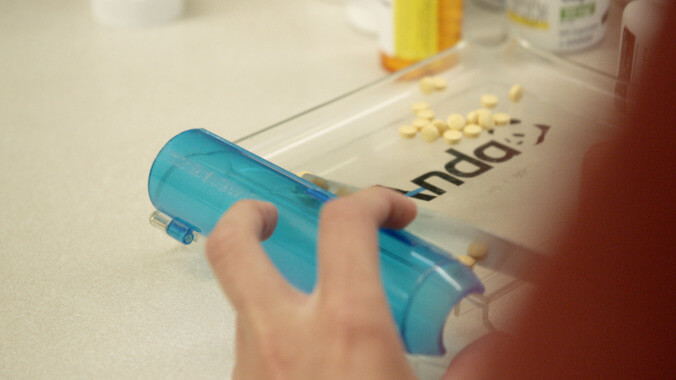HBO’s The Crime Of The Century is an incisive but fragmented look at the opioid crisis

The Crime Of The Century packs an incredible amount of striking, heartbreaking information as it charts the opioid crisis in the U.S. The HBO documentary is divided into two two-hour installments. The length can feel overwhelming because of the scope, but writer and director Alex Gibney’s challenging exploration of the subject matter justifies the runtime. The docuseries dives into the history of how pharmaceutical companies began and fueled the crisis in the 1990s; the duplicity of the healthcare industry; and the government’s failure to stop the drug push. Over the last two decades, opioid overdose-related deaths totaled nearly 500,000, according to the CDC. The Crime Of The Century is a fastidious attempt to track how this became a widespread epidemic; but it still feels like it’s just scratching the surface.
The docuseries is essential viewing for anyone looking to learn about the drastic losses caused by the greed of a few influential industrialists, medical professionals, and government employees. But when tallying up those losses, it overlooks the marginalized communities most gravely impacted by the opioid crisis. At no point during its combined four-hour run time does the docuseries even mention how people of color or those from impoverished backgrounds were disproportionately affected. The Crime Of The Century isn’t about the victims of the opioid crisis but the villains of this situation, offering a much-needed look into how intense marketing pushes and fraudulent insurance claims helped cause this chaos in the first place.
The Crime Of The Century is a well-researched deep dive into the rise of the illegal distribution of Oxycontin, fentanyl, and heroin over the years, focusing on a few of the players who were directly responsible. The first part centers on Purdue Pharma leaders and owners, the Sackler family, who financially benefitted when the company started distributing Oxycontin in 1996. Their devastating decision to ignore how their drugs cause addiction and death set the course for other medical companies to do the same. The second episode dwells more on how the Drug Enforcement Agency (DEA) tried to build a case against several of them, featuring interviews with agents like Joseph Rannazzisi, who was kicked out of the agency after pushing for investigations of drug companies.
“Part One” starts off with Purdue Pharma’s Oxy push in the ’90s, scrutinizing the corruption of the industry as the company instructed sales representatives to partner with and even bribe doctors to prescribe heavy dosages (originally meant to help cancer patients) to patients coming into clinics for something relatively minor, like muscle pains. This not only led to the evolution of “pill mills,” but eventually the drugs got onto the black market and users figured out ways to crush or intravenously take the pills. As written communication and other evidence in the documentary suggests, Purdue Pharma executives and members of the Sackler family were aware of this and blatantly ignored how addicts could fatally misuse the drug. It’s no surprise to learn the Sacklers are worth billions. The Crime Of The Century is a horrifying tale of how these leaders capitalized on disregard for public safety, and were able to afford buying luxurious hotels and homes in the same towns drastically affected by drug use.
These gripping facts bring emotional severity to the documentary, which is full of statistics on the increased rate of online pharmacies, the boom in illegal pill clinics in Florida (Broward County had 142 at one point), and the damage they caused. That depth also comes through interviews with people like Roy Bosley, whose wife died from addiction. Carol Bosley was a patient of Dr. Lynn Webster, who founded Lifetree Pain Clinic and prescribed Mrs. Bosley a mix of intense drugs when she went in for back pain. The documentary reveals that approximately 100 of his patients suffered similar fates. In 2013, the DEA opened an investigation into his practice. Dr. Webster is interviewed in The Crime Of The Century, and his negligence is as provoking as the comments from Alec Burlakoff, the VP of sales for Insys Therapeutics, who features in the second half of the docuseries.
Purdue Pharma laid the groundwork for pharmaceutical companies like Insys to later push hazardous drugs like fentanyl in various forms, including lollipops. Burlakoff, who worked for Eli Lily, Johnson & Johnson, and Cephalon, played a major role in supplying fentanyl-based pain medication and defrauding healthcare insurers. The methodical strategy for the latter is laid out with the help of reenactments. This slight dramatization is distracting, as are the abrupt needledrops of songs like Billy Joel’s “My Life,” which come off as jarring in an otherwise serious documentary. The second episode also condemns politicians like Rudy Giuliani, Marsha Blackburn, and Tom Marino for falling prey to lobbying and then halting DEA cases investigating the drug supply chain. This string of events is presented through footage of press conferences and Congressional sessions, also showing exactly how much they were each paid.
The Crime Of The Century is a massive undertaking because it’s nearly impossible to summarize the intensity of the opioid crisis in just four hours. Gibney is a prolific documentarian whose works include The Inventor: Out For Blood In Silicon Valley and Going Clear: Scientology & The Prison Of Belief. His efforts here work to educate audiences about the people involved in starting and perpetuating this disaster, as well as the amorality and staggering class difference that led to a wholly avoidable epidemic. The documentary presents a data overload, but one that is still a statistical overview as opposed to a more in-depth look at the ramifications of the people who suffered. The Crime Of The Century isn’t able to paint a complete picture, but it’s still a powerful and edifying watch.